| Article ID | Journal | Published Year | Pages | File Type |
|---|---|---|---|---|
| 1395682 | European Polymer Journal | 2014 | 11 Pages |
•We have reported on modified PVK as a functional host for PLED applications.•The di(4-tolyl)aminobenzyl (DTAB) grafted PVK could be obtained as the major product.•DTAB grafted PVK reactions mechanisms are elucidated by 1H NMR study.•The device lifetime has also been improved 1.36 times (compared with PVK device).
DTAB-PVKs are prepared by post-functionalization of poly(N-vinylcarbazole) (PVK) with di(4-tolyl)aminobenzyl acetate (DTABOAc) as the pendant groups via the Friedel–Crafts reaction. Introduction of the methyl substituents at the para-position of DTABOAc is essential for suppression of its self-condensation. The details of the reactions mechanisms are elucidated by 1H NMR study. The Fermi level of DTAB-PVKs could be tuned by controlling the amounts of DTABOAc content in the polymer and DTAB-PVKs are found to be good hosts for phosphorescent polymer light-emitting diodes (PLEDs). In a device of PLED comprising PEDOT: PSS/DTAB-PVK-Ir(ppy)3-PBD/Mg–Ag, low turn on voltage at 6.5 V is found with a reasonably high current efficiency of 11.5 cd/A at 13.0 V. The power efficiency reaches 2.7 lm/W at 12.0 V. More importantly, the device performance related to the Fermi level of DTAB-PVKs.
Graphical abstractFigure optionsDownload full-size imageDownload as PowerPoint slide
